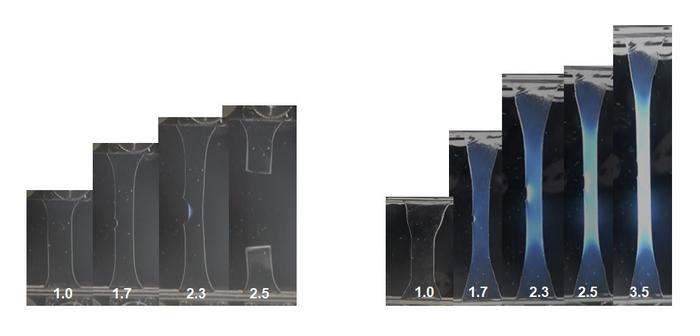
Researchers at Hokkaido University and Duke University have reached a significant breakthrough in the field of materials science by developing a novel hydrogel that possesses remarkable self-healing properties. This innovative double-network hydrogel transforms the understanding of material durability by allowing it to mend itself in real-time as it is subjected to stress and damage. The implications of this discovery could revolutionize the design of soft yet resilient materials crucial for load-bearing applications in diverse fields, ranging from engineering to biomedical devices.
Hydrogels are versatile materials that have gained attention due to their ability to retain large amounts of water, making them useful in numerous everyday items, such as contact lenses, personal care products, and even biomedical implants. Despite their broad applications, creating hydrogels that are both soft and resistant to tearing has proven a complicated challenge. Traditional hydrogels can easily be deformed, but their structural integrity often fails under prolonged stress, leading to irreversible damage—akin to pushing down on a Jell-O mold until it splits.
The innovative approach taken by Jian Ping Gong at Hokkaido University introduced the concept of double-network hydrogels back in 2003. In these advanced materials, a resilient but brittle internal structure is incorporated into the softer exterior, aiming to enhance strength and durability. This layered structure allows the material to withstand greater stresses while providing flexibility, reminiscent of car tires—soft on the outside but reinforced with a network of carbon particles for enhanced performance.
However, one significant limitation of traditional double-network hydrogels is their inability to recover once their internal networks are damaged. Once the interconnected matrices break, they cannot revert to their original form, marking a crucial barrier to their practical applications. To counter this challenge, researchers have sought to create hydrogels that can heal themselves in real-time, though previously developed self-healing techniques were constrained by slow healing rates, limiting their practical usefulness.
In their recent publication in the journal Nature Materials, Gong, Rubinstein, and their colleagues unveiled a breakthrough in the development of self-healing double-network hydrogels. Their innovative technique allows for rapid healing, significantly outpacing previous attempts while simultaneously enhancing the material’s strength. The researchers achieved this by embedding sacrificial segments within the hydrogel’s internal structure. These segments are designed to break easily under stress, unleashing reactive radicals that initiate swift healing mechanisms.
The mechanics behind this phenomenon are fascinating. When a part of the hydrogel’s internal structure ruptures, the newly exposed ends release radicals. These radicals react with nearby monomers—simple molecules that can link together to form larger structures—creating new chains and crosslinks to form a fresh supporting network. This process effectively enables the hydrogel to reinforce itself at the site of the damage, combining self-healing and self-strengthening capabilities in a singular process.
As a direct result, this novel hydrogel exhibits an impressive capacity to resist both cracking and other forms of damage. The researchers documented their initial proof-of-concept, noting that the material could keep pace with crack formations at a rate of approximately two inches per minute. While this may seem slow, it has profound implications across numerous sectors where gradual wear and degradation are of primary concern, such as in engineering components subjected to constant stress or in biologically inspired materials.
This research represents just the first step in what will undoubtedly be an extensive exploration into the potential of dynamic hydrogels. Michael Rubinstein from Duke University emphasized that this initial version is merely a foundation for future developments. Ongoing efforts will delve into creating robust computational models to investigate these internal dynamics further, paving the way for optimizations that could enhance the speed and efficacy of the self-healing processes.
Looking ahead, the promising applications of these advanced hydrogels are vast. Their unique qualities could be harnessed in soft robotics, where materials need to endure continuous deformation while retaining functionality. In the medical arena, such hydrogels could be transformative for suturing wounds or for creating implants that mimic biological tissues, which demand both flexibility and strength. Furthermore, the ability of these materials to self-repair represents a potential game-changer for developing more resilient and longer-lasting products in engineering and technology.
The research team recognizes that while their findings are groundbreaking, they serve as a prelude to even more sophisticated versions of these materials. Future iterations aim to enhance healing rates and develop customized properties to cater to an even broader range of applications. This ambitious vision embodies the spirit of scientific inquiry, demonstrating how foundational discoveries can lead to innovative solutions that expand the boundaries of material science.
To summarize, the collaboration between researchers at Hokkaido University and Duke University signifies a leap forward in the realm of hydrogels. The pursuit of materials that not only withstand but also self-heal under pressure might redefine our approach to designing soft materials. As this field of research evolves, we can anticipate a future where self-reinforcing materials find a critical place in shaping sustainable technologies that adapt and restore themselves under real-world conditions.
In conclusion, the innovative self-healing double-network hydrogels crafted by these researchers hold immense promise. With continued exploration and development, these materials could lead to revolutionary advances in multiple sectors, enhancing our interaction with technology and biology alike in ways previously thought unattainable. The synergy of resilience and self-repair encapsulates the essence of what modern materials science strives to achieve, paving the way for an exciting future ahead.
Subject of Research: Self-healing double-network hydrogels
Article Title: Rapid self-strengthening in double-network hydrogels triggered by bond scission
News Publication Date: February 26, 2025
Web References: DOI Link
References: Nature Materials Journal, Zhi Jian Wang et al.
Image Credits: Credit: Hokkaido University
Keywords
Hydrogels, Self-healing materials, Polymer chemistry, Soft matter, Materials engineering, Mechanical engineering.
Tags: biomedical applications of hydrogelschallenges in hydrogel developmentdouble-network hydrogel technologyengineering advancements in hydrogelsinnovative hydrogel designload-bearing soft materialsmaterials science breakthroughsreal-time material durabilitysacrificial scaffolding in materialsself-healing hydrogelsstructural integrity of hydrogelsversatile hydrogel applications





